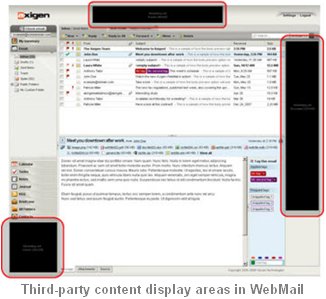Free email services based on Web-centric platforms have long been used as advertising delivery agents. This hybrid approach to compensating for the expenses of running a free service has opened the door to a brand new and very useful customer information strategy that can be used to your full advantage, no matter what messaging environment you have deployed.
Although the idea came as a result of the need to monetize a free service, it has currently expanded to a great extent and is no longer used for advertising purposes exclusively. Ads still hold a large share of third-party content delivery systems and this will certainly not change dramatically in the near future. However, third-party Web content can be used for a variety of different reasons, some of them even more powerful than ads, depending on the deployment scenarios.
Third-party Content Delivery
Third-party content is usually represented by certain regions of an Axigen WebMail page that display content (usually targeted content) which is loaded dynamically either based on the user’s current activity, the account status or on the history of the user’s behavior. The content to be loaded resides in a third-party location in most situations, but local content (stored on the same server) is not excluded. It is referred to as third-party content to underline the ability to load external information into local pages and is unrelated to any limitation in this respect.

The actual information can consist of any HTML page or content that can be rendered in HTML by the Web browser. This includes the more visible images, buttons, forms, JavaScript code and Java applets (client side) content and less obvious Flash or Silverlight interactive content.
The data represented in these small content regions can have multiple purposes, ranging from the latest information updates to ads and even specialized widgets. For this purpose, it is not unusual to find a weather report widget in one of the WebMail content areas, and commercials in another.
Combinations of different content types are easy to achieve and require very little effort to set up, as the building blocks that make this possible are readily available.
Enterprise Environments
In regular enterprise environments, third-party content is pretty much ignored and left out of the loop, mainly because of its association with advertising and commercials. However, in a WebMail interface, designed to enhance the productivity of the employees that use it, third-party content delivery can provide the next generation of live information delivery.
For example, a very useful application for the financial and sales departments would be an exchange rate applet, displaying updated information on the current rates and latest trends of the most important currencies. Just as well, but in a different usage scenario, for the marketing department, an applet with statistics on recent customer activity could offer information on important events or activities.
Academic & Educational Environments
Universities and other educational institutions that have an ever changing end-user base can make great use of the third-party content delivery system for informational purposes, by coupling it with targeted information that may be of direct interest to students and trainees. Of course, general information such as public events and recent news that should be of interest to everyone can be provided more freely, just like with regular advertising. On the other hand, sensitive information can also be made available through authentication, as the case may be with online report cards and test results.
If such an environment is created, the Axigen WebMail users will have far more relevant information at their fingertips, enabling them to get better and faster feedback as well as a means to reduce the time they invest in searching for details of high importance to them.
Value Added Services & Advertising
The latest developments in the online ads market have resulted in a lower penetration rate of this delivery method, especially in ad-supported platforms. However, the value added services trend has been on the rise, essentially creating leverage to compensate for the recent decline of regular online ad delivery.
Regular banner-like and other well-known approaches to online ads are all supported with the Axigen WebMail. On top of being able to display banners, interactive content (such as Flash) and simple text ads for “other stuff”, the third-party content delivery system can also advertise the added services offered by the platform you provide, enabling users to seamlessly “go pro” and start generating revenue through the platform subscription you already have in place.
Value added services can include the old-school approach that simply removes the ads being displayed, or they can push the boundaries even further, by allowing new customers to configure their own widgets, using the browser cookie system to remember their choices when they return. Configurable widgets are nothing new, but they have established themselves as the new status quo, so making use of them would be a more than reasonable practice.
Conclusions
To summarize, the possibilities of using third-party content on a public or private messaging service are literally endless. Choosing between productivity enhancement, targeted information delivery and regular commercials remains the biggest hassle, in the end. With the new Axigen AJAX Webmail you can use any of them or, even better, all of them at once in order to achieve the right experience for your target audience. With Axigen, you get power through simplicity, allowing you to concentrate on the business strategy, instead of finding a way to make it work.
![]()